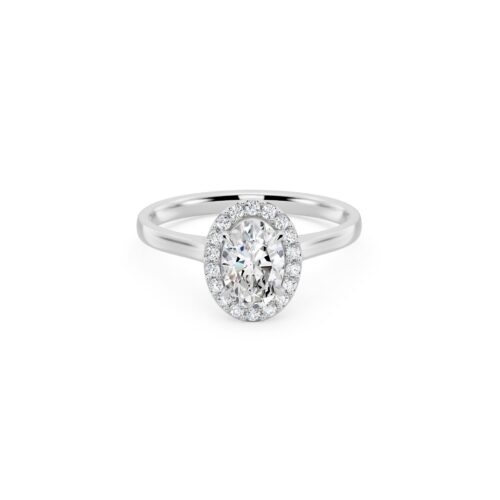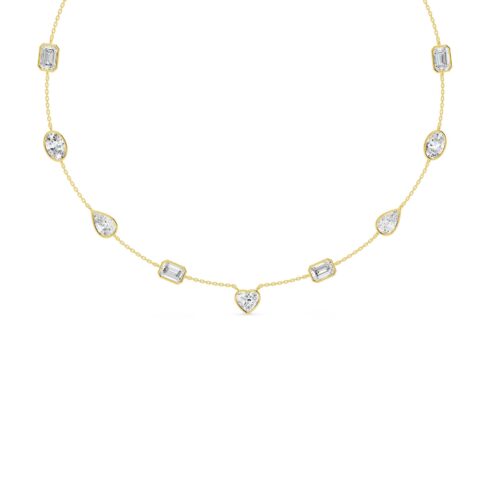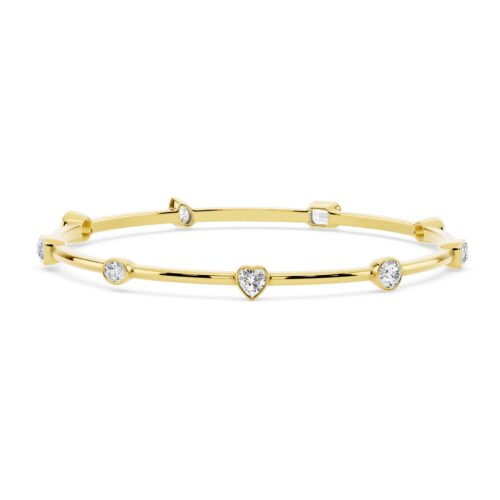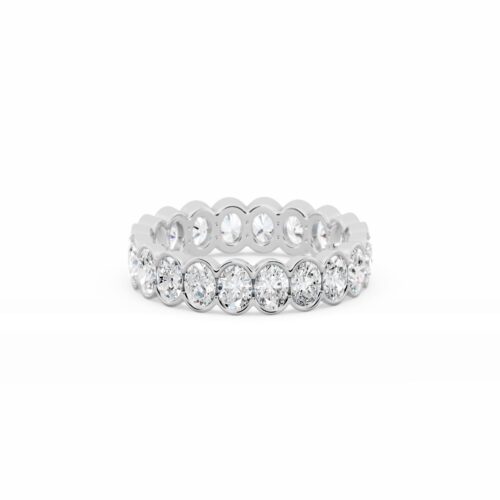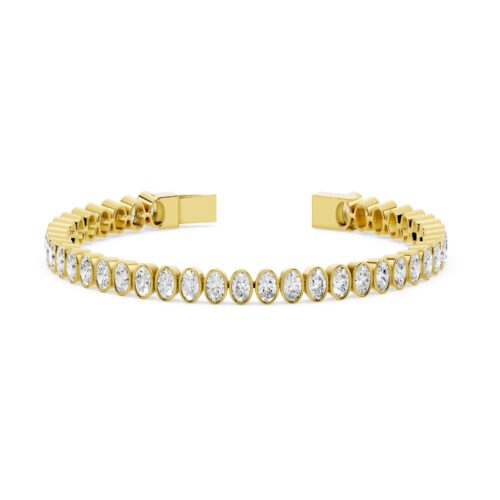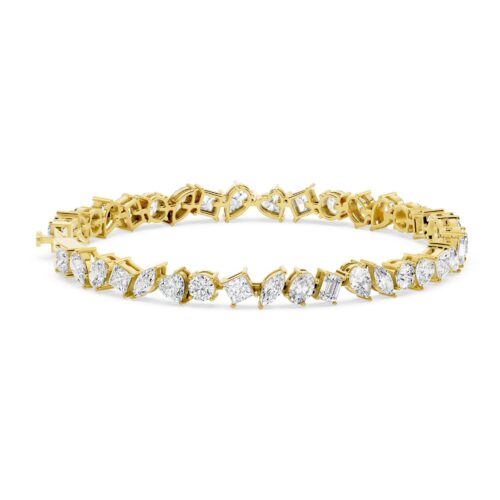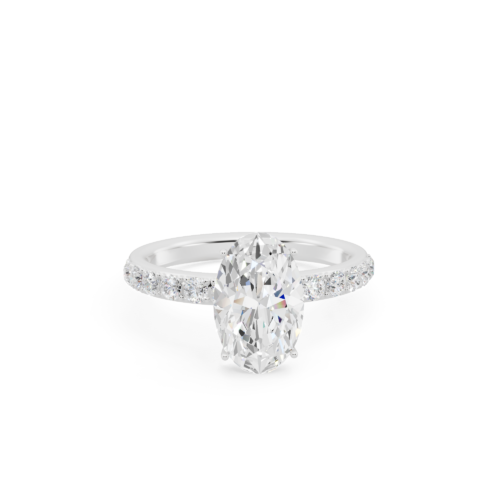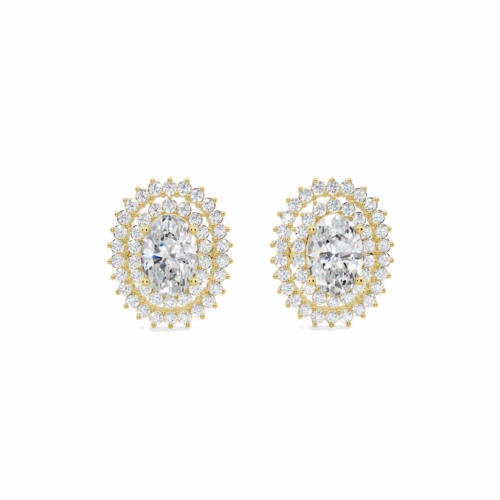Lab-Grown Diamond Oval Solitaire Rings: Science, Style, and Substantive Answers
What Makes Lab-Grown Oval Solitaire Rings So Captivating?
An oval solitaire ring—especially one with a lab-grown diamond—combines elegance, optical performance, and ethical value in ways that appeal to both connoisseurs and conscientious consumers. The oval cut, with its elongated shape and brilliant facets, magnifies visual size and lengthens the appearance of fingers; the solitaire setting puts the diamond front and center, minimal distractions; lab growth gives you the same carbon crystal structure as natural diamonds, often at lower cost and with fewer ethical and environmental ambiguities.
In this article, we examine everything: from the origin of lab-grown diamonds, to the 4Cs as they apply, to design choices and trade-offs. We’ll also dive into frequently asked questions, address common doubts, and provide guidance for buying, caring for, and valuing these rings—especially in India and globally.
Defining Terms: Lab-Grown Diamonds, Oval Cut, Solitaire
What is a lab-grown diamond?
Physics/chemistry: Lab-grown diamonds are diamonds that are grown in a controlled laboratory environment via methods such as Chemical Vapor Deposition (CVD) or High Pressure High Temperature (HPHT). They are chemically, physically, and optically identical to mined diamonds, both being crystalline carbon.
Certification & quality: They are graded by gemological labs (e.g. IGI, GIA, GCAL) on the same or analogous parameters (color, clarity, cut, carat) though there are industry discussions about evolving grading standards.
Ethical / environmental context: Because they avoid geological mining, concerns around conflict diamonds, labor abuses, and certain environmental harms are reduced; but lab-growth still has energy demands and carbon footprint depending on how power is sourced.
The Oval Cut: Advantages & Challenges
Shape & aesthetics: The oval cut elongates the look of the finger, gives a larger table (top facet) for spread, while still retaining brilliance.
Optical behavior: It can suffer from the “bow tie” effect—a dark shadow region across the center—if poorly cut. The length to width ratio matters: too long, and it appears thin; too wide, and it loses that graceful elongation.
Comparisons: In contrast to round brilliant, oval tends to stretch the optical area; against pear, marquise, etc., it’s more forgiving on symmetry; compared to cushion or princess etc., more elegant and less edgy.
What is Solitaire?
Definition: Solitaire means a single center stone, typically with minimal prongs or claws to hold the stone, no side stones.
Symbolism & appeal: Let the stone speak for itself. Purist, timeless, easier to clean/maintain, classic shape that rarely goes out of style.
The 4Cs & Quality Metrics for Lab-Grown Oval Solitaires
Here we treat each of the 4Cs (Color, Clarity, Cut, Carat) with specifics for oval cuts, especially in lab growth contexts. We also introduce additional metrics that are gaining importance in consumer decisioning.
4Cs & Quality Metrics for Lab-Grown Oval Solitaires
| Metric | What to Look For | How it Differs / Matters in Oval + Lab-grown Context |
|---|---|---|
| Cut | Proportion (length-to-width ratio), symmetry, polish, facet structure, and maximizing spread (how big it looks for its carat). | Oval cuts can hide asymmetry; poor cut yields harsh bow-tie. Lab-grown diamonds are often cut with precision; but you must inspect cut grade & vendor honesty. |
| Color | For oval cuts, color shows up in widest parts; yellowness may be more visible on white gold settings. | Lab diamonds can offer higher color grades (like D-F) more affordably; choose based on budget & setting metal. |
| Clarity | Inclusions in oval may be less visible at edges, but clarity still matters for brilliance; inspect with jeweler’s loupe. | Lab-grown clarity grades are similar to natural; but internal growth features may differ. |
| Carat / Spread | Because oval shapes have larger face-up area, a 1.0 ct oval often looks larger than a 1.0 ct round. | Enables better value for face-up look in lab-grown options. |
Additional metrics to consider:
Length-to-Width Ratio (L/W): Often between ~1.30–1.50 is considered “classic oval” shape. Below or above that gives more squat or more elongated look.
Bow-tie effect: Degree of dark shadow—important to assess via images / in person.
Fluorescence: For some lab diamonds, fluorescence can impact face-up appearance, especially under UV or sunlight.
Origin, traceability, sustainability credentials: For many buyers, lab-grown rings’ ethical / environmental positioning is a major factor.
Versatile Oval Diamond Halo Stylish Ring 18kt & 14kt Gold
Timeless Oval Solitaire Diamond Ring in White, Yellow, or Rose Gold
Pricing and Value Considerations
Why Lab-Grown Oval Solitaire Rings Often Deliver More Bang Per Buck
Because of lower supply chain overhead (no mining extraction, less logistics, fewer middlemen), lab-grown diamonds generally cost significantly less than comparable natural diamonds. You often get:
Higher carat for the same budget
Better color or clarity for same price tier
More predictable specifications
What You Sacrifice (or Trade Off)
Resale / resale value: Natural diamonds historically hold value (though not always appreciating any real monetary return). Lab-grown diamonds have depreciation and less established secondary markets.
Perceptual / sentimental value: Some consumers prefer the “natural story” of mined diamonds; for others, that matters less than ethics or design.
Certification changes: Recently there are changes in how labs certify lab-grown diamonds; for example, GIA has reportedly adjusted how it treats the 4Cs for lab-grown stones. The Economic Times
Design & Metal Choices in Oval Solitaire Rings
Setting Styles
Prong settings: 4-prong, 6-prong. 4-prong gives more visibility of the gem; 6-prong can offer more security.
Bezel / partial bezel: For protection; sacrifices some brilliance.
Cathedral, knife-edge, split shank: Variations that change how the band meets the stone. While solitaire is minimal, these styles add flair without extra stones.
Metals & Finishes
Gold types: 18K vs 14K yellow, white, rose. White gold often rhodium-plated; over time plate may wear.
Platinum: More durable, naturally white; heavier and more expensive; can scratch but patina builds.
Mixed metals / two-tone: Less common in traditional solitaire, but can offer contrast, especially with settings/claws.
Size / Proportion & Fit
Matching stone size to hand anatomy (finger length, width). Elongated oval looks good on shorter fingers; L/W ratio is important.
Band thickness: too thin a band may not complement heavier stones; too thick may overpower.
Prong style & height: overly high settings may snag or be less secure; low settings may hide brilliance.
Ethical, Environmental, and Quality Assurance Dimensions
Ethical & Environmental Impact
Conflict-free sourcing: Lab-grown removes many layers of risk from mining (human rights, conflict zones).
Energy usage / carbon footprint: Lab growth still consumes energy; impact depends heavily on energy source (renewables vs fossil fuel). Transparency matters.
Certification and traceability: Ensure vendor provides credible certificates (IGI, GCAL, etc.), and discloses origin, growth method.
Quality Assurance
Laboratory certification: Always insist on a lab-report; for example, IGI, GCAL, or GIA (noting changes).
Reviews, vendor reputation: Customer reviews, images, return policy.
After-sale services: Resizing, cleaning, warranty, insurance.
Frequently Asked Questions & Common Doubts
Here are the questions people often ask; each with detailed answers.
Is a lab-grown diamond “real”? Can it be distinguished from a natural diamond?
Yes, lab-grown diamonds are “real” diamonds in the sense of being the same material—crystalline carbon, same hardness, same refractive index, etc. Distinguishing may require specialized equipment; gemological labs can differentiate based on growth patterns, inclusions, etc. Many lab-grown diamonds are certified, so you have assurance.
Will people notice it’s lab-grown? Will it affect prestige?
Visually, in daily wear, very few people can distinguish unless they are told or inspect very closely. Prestige is subjective: for some, having a mined diamond is a status symbol; for others, ethical aspects are more important. Trends are shifting: younger consumers often prefer responsible luxury, so lab-grown carries prestige in its own right.
What about resale value and long-term investment?
Natural diamonds have more established secondary markets, especially for high quality stones. Lab-grown diamonds currently depreciate more, and resale is harder. If you buy mainly for emotional or aesthetic value rather than financial return, lab-grown is often more satisfying per rupee. If investment is key, natural may still have edge, with caveats.
Are lab-grown diamonds more sustainable? What are the environmental trade-offs?
Generally more sustainable in terms of avoiding mining disruption, deforestation, human/child labor issues, conflict. However, lab growth uses electricity; unless that electricity comes from renewable sources, carbon impact can still be significant. Always check vendor’s transparency about manufacturing, sourcing of power, etc.
How do I choose a good oval cut so I don’t end up with a bad bow-tie effect?
Key factors:
L/W ratio: choose one that balances elongation and breadth (often ~1.30-1.40 for classic oval look).
Inspect images from different angles, especially with light behind the stone to see shadow/bow-tie.
Ask the vendor for details: facet layout, symmetry grade, polish.
In some cases, seeing in person is best, but high-quality vendor photos or videos (360°) can help.
How much should I expect to pay? What are price ranges in India and globally?
It depends on carat size, color, clarity, cut, metal, brand. In India, lab-grown solitaire rings of moderate size (say ~1 carat, good color & clarity) can be quite competitive vs mined. Premium pieces (large carats, top color/clarity, platinum or designer brand) will cost more. Always compare equivalent 4Cs and certificate.
What about certification? How important is it?
Extremely important. A credible lab report ensures you know what you’re getting: who graded it, what standards used, what exact parameters. Certificates from IGI, GCAL etc are reliable. It helps in after-sale, resale, insurance. Note: some labs are more trusted than others.
Can lab-grown oval solitaire rings last long? How about durability & maintenance?
Yes. Diamond (natural or lab-grown) is one of the hardest known materials. Physical hardness is same. Wear and tear mostly affect the setting, prongs, band. Maintenance: periodic checking of prongs, cleaning, proper storage. Metal scratches etc is independent of the diamond type.
Geo-Specific & Market Context: India & Global Trends
Lab-Grown Diamonds in India
Production & expertise: India is a global hub for diamond cutting and polishing; increasingly involved in lab-grown manufacturing. This gives advantages in cost, craftsmanship, and local customization. E.g. providers like Anyra Diamonds offer oval lab-grown solitaire rings, with BIS hallmark and IGI / SGL certification.
Consumer awareness: Rising, especially among millennials / Gen Z. Ethical, sustainability, good value are motivating factors.
Price sensitivity: Much stronger—consumers want the best value; lab-grown fits well.
Regulatory, hallmarks, tax, etc.: Familiarity with BIS hallmarking for metals, import duties etc plays a role. Transparency around certification is essential.
Global Market & Trends
Growing market share: Lab diamonds are catching up in popularity, especially for engagement rings.
Evolving certification: Some labs (e.g. GIA) changing how they issue reports for lab-grown stones. Buyers must stay updated.
Perception: More acceptable, less stigma. But natural diamonds still retain value for collectors, luxury positioning.
Technological improvements: Better growth methods, more consistency, improved cutting, reduced energy consumption in lab growth.
How to Choose the Perfect Lab-Grown Oval Solitaire Ring: A Step-by-Step Guide
Here is a checklist, almost algorithmic, for selecting a ring that balances beauty, budget, and values.
Set your budget
Decide overall budget (include setting + diamond). This will guide choices in carat, clarity, color.Decide priorities
What matters more: face-up size? brilliance? maximum ethical credentials? resale potential? aesthetic style?Choose the diamond first (stone metrics)
Decide carat (face-up spread vs weight)
Decide color grade acceptable (e.g. D-F if budget allows; maybe G-H if you prefer more carat)
Decide clarity threshold (VS/VVS often safe)
Inspect cut & L/W ratio; ask for images/videos, perhaps from seller or lab.
Choose setting & metal
Metal type: 18K gold / platinum etc.
Prong style: 4 or 6 claws; prong height; security vs display.
Band thickness and profile.
Check certification & vendor trustworthiness
Ensure lab report; authenticity of vendor; return policy; after-service (resizing, maintenance).
Check whether ring is BIS-hallmarked (in India) for metals.
Observe in-person / via high fidelity images
When possible see sample; otherwise request detailed visuals including lighting to see possible bow-tie, inclusion, polish flaws.Maintenance & insurance plan
Plan for cleaning, insurance (especially for higher carat), prong checking; store properly.
Common Myths & Misconceptions
| Myth | Reality |
|---|---|
Lab-grown diamonds are fake. | They are not fake — lab-grown diamonds are chemically and physically identical to natural diamonds. The primary difference is origin and market dynamics. |
They look less brilliant. | Not true if the diamond is well cut. Brilliance depends on cut quality, not origin. |
Lab-grown diamonds are always cheaper but always inferior. | While lab-grown diamonds typically cost less, many are exceptional in quality. Buy from certified and transparent vendors. |
Natural diamonds are better investments. | Investment value varies. Most jewelry purchases are for personal meaning rather than financial returns. |
There’s no difference in environmental impact. | There is a difference: lab-grown diamonds generally avoid mining harms, but their footprint depends on energy sources and manufacturing transparency. |
Final Thoughts: Is an Oval Solitaire Lab-Grown Ring Right for You?
If I were to summarise as if advising a doctoral seminar on luxury goods, here is the decision framework:
Identity and values alignment: If ethics, sustainability, transparency matter to you, lab-grown is strongly favourable.
Budget vs visual impact: If you want the maximum visual presence (face-up size, brilliance) for a given budget, lab-grown oval solitaire is very strong.
Longevity and resale: If you might resell later or hand-down with expectation of retained market value, carefully choose stone quality, consider natural vs lab, research resale markets.
Aesthetic priorities: The oval plus solitaire setting is timeless; minimalist, clean; if you prefer ornate or vintage, consider adding halos, pavés—but that moves away from pure solitaire.
Due diligence: Certification, trustworthy vendor, well-cut stone, clarity appropriate, proper metal, warranties.
Conclusion
Lab-grown diamond oval solitaire rings occupy a sweet spot: they combine elegance (through the oval cut and solitaire simplicity), value (getting more for less), and ethics. For many consumers in India and globally, they represent a conscious luxury—beautiful and meaningful without unnecessary cost, environmental or ethical compromise.
As with any high-value purchase, the keys are knowledge and care: understand the 4Cs + extra metrics, demand great cut & transparency, choose metals and settings that complement both stone and wearer, and buy from vendors with strong reputation and certification. If these boxes are ticked, a lab-grown oval solitaire ring can deliver lustre, love, and longevity.

